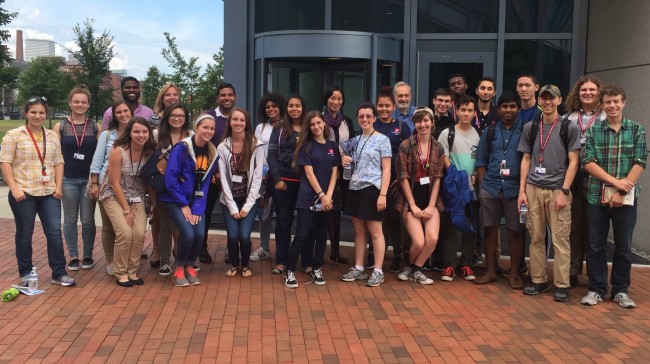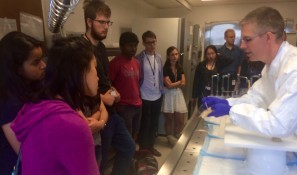Teens Experience the “Cool” Side of Science in Summer Visits
It may seem surprising to hear teenagers refer to science as “cool,” “exciting,” or “intense,” but those are the adjectives high school interns used to describe their experiences at Boston University Medical Campus (BUMC) labs this summer.
The Medical Campus is partnering with the Museum of Science on initiatives aimed at attracting more students to science, technology, engineering, and math (STEM). The collaboration includes opportunities for BUMC faculty and students to participate in public programming at the Museum, provide mentor experiences, and increase student exposure to STEM activities and fields.
The partnership grew out of recognition that the US needs more workers proficient in STEM fields, but these disciplines are failing to attract an adequate number of students. According to the US Department of Education, only 16 percent of American high school seniors are proficient in math and interested in a STEM career. What’s more, only half of those who major in a STEM field in college ultimately pursue a career in STEM.
“By creating powerful and engaging experiences for students that highlight BU’s groundbreaking research, we can inspire the excitement of science and spark student interest in biomedical science,” said Karen Antman, MD, BUMC Provost and BUSM Dean.
As part of the new collaboration, teen summer interns from the Museum visited the Boston University National Emerging Infectious Diseases Laboratories (NEIDL) and the VA/BU/Concussion Legacy Foundation Brain Bank this summer.

Twenty-five teens toured the NEIDL, located on the Medical Campus. The facility houses state-of-the-art technology used by world renowned researchers to study infectious diseases that pose the greatest threat to public health. Gerald T. Keusch, MD, Associate Director of the NEIDL, talked with the students about infectious diseases such as Ebola and Zika and how they are studied. He encouraged the students to think about all of the careers involved in disease research and the impact those professionals have on public health.
“The visit reminded me that there are so many cool careers out there that I’ve never thought about, so I should keep my mind open,” said one student.
Keusch also gave a tour of the labs and mechanical space and explained the stringent safety protocols in place at the NEIDL. Students learned about the special suits and other equipment required for working in biosafety levels two, three and four, including extensive didactic, simulation, and mentored training.
The visit concluded with an opportunity for Q&A. One student asked Keusch how he felt when a disease that has been eradicated, or nearly eradicated, resurfaces due to people not vaccinating their children.
“We as scientists need to be better communicators,” Keusch answered. “Perhaps some of you will help with that.”
Research Assistant Katharine Babcock led another group of 25 teens on a tour of the VA/BU/Concussion Legacy Foundation Brain Bank, led by Ann McKee, MD, professor of Neurology and Pathology; Director of the Neuropathology Core and the CTE Program for the Alzheimer’s Disease Center; Chief of Neuropathology, VA Boston Healthcare System.
The event marked the first time a large group of students visited the brain bank. Researchers Bertrand Huber, MD, PhD, assistant professor of Neurology and Victor Alvarez, MD, postdoctoral fellow, explained how trauma-related brain disorders, including Chronic Traumatic Encephalopathy (CTE), manifest and how they are studied.

Students were then able to observe and ask questions as Thor Stein, MD, PhD, assistant professor of Pathology and Laboratory Medicine worked with a donated brain and spinal cord. Stein explained brain structure to the students as he cut the brain into layers, pointing out areas that researchers look at to investigate injury and illness.
“I am interested in psychology, so seeing a real brain was very exciting for me. The tour also made me think about my interest in medicine and whether I’d like to go more into a research job or not,” said one teen participant.
The collaboration will continue this year with programs featuring faculty and students at the Museum and additional teen field trips to campus during the coming year.
“The experiences at BU generated excitement for the teens around the truth that science lives and is constantly changing,” said Elizabeth Kong, PhD, Manager of the Museum’s Hall of Human Life. “They can see themselves in a career they may never have imagined.”
Submitted by Monica Parker-James.